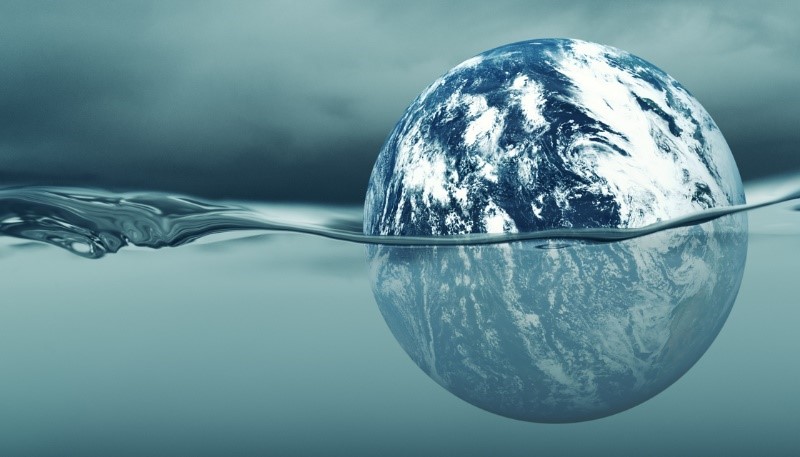Description

Disclaimer: Copyright infringement not intended.
Context
- The World Meteorological Organization (WMO) recently, released the report, entitled ‘State of the Global Climate 2022’.
Findings of the Report
Rise in Sea Level
- The world’s sea level is rising at an unprecedented rate. This will have potentially disastrous consequences for the weather, agriculture, the extant groundwater crisis, and social disparities.
Measuring the rise in sea-level
- Since the 1990s, scientists have been measuring sea-level rise using satellite altimeters.
- These instruments send radar pulses to the sea surface and measure the time they take to get back and the change in their intensity. The higher the sea level, the faster and stronger the return signal.
- Researchers are able to determine GSML by collecting this data from different points on the earth and calculating the average. To calculate the rate of change in the Global Mean Sea Level (GSML) – i.e. how fast or slow the sea level is changing – we can calculate the difference in the GSML across a few years, usually a decade, and then divide the difference by the number of years. This provides an estimate of the rate of sea-level change.
How much is the sea rising?
- The rate of global mean sea-level [GSML] rise has doubled between the first decade of the satellite record and the last.
- The sea level has been rising in the three decades for which satellite altimeter data is available (1993-2022).
- But while the rate of sea-level rise was 2.27 mm/year in 1993-2002, it shot up to 4.62 mm/year in 2013-2022.
Factors responsible for a rising GSML
Ocean warming
- Ocean warming – the phenomenon of rising mean ocean temperatures – contributed 55%, and changes in the storage of land water contributed less than 10%.
Ice loss from glaciers and ice sheets
- Between 2005-2019, loss of glaciers and ice sheets contributed 36% to the GSML rise.
- The earth’s ice cover, known as the cryosphere, has thinned. The cryosphere includes the Arctic and Antarctic regions (called “sea ice”), glaciers, the ice sheets of Greenland and Antarctica (area of ice on land covering more than 50,000 km 2), seasonal snow cover, and permafrost (mass of land that remains below 0º C for at least two straight years).
Changes in land water storage
- Sea level rise (SLR) will cause shallow unconfined coastal aquifers to rise.
- Rising groundwater can emerge as surface flooding and impact buried infrastructure, soil behavior, human health, and nearshore ecosystems.
Increase in Co2 and Green House Gases.
- As increasing concentrations of carbon dioxide and other greenhouse gases drive global warming, 90% of the ‘extra’ heat is stored in the oceans.
- This leads to ocean warming. And as the ocean heats up, it undergoes thermal expansion, which in turn leads to a rise in the GSML.
- One measure of ocean warming is the ocean heat content (OHC).
- As per the report, OHC measures in 2022 touched a new record.
What problems will sea-level rise cause?
Changes in Land Cover
- The accelerated pace will cause changes in land cover, i.e., “what will be land and what will be sea”, in the future.
- As rising seas swallow more of the land cover, particularly in coastal areas, coastal communities will face an “acute shortage of land for human use”.
- This land crunch, will mean that those who are better off will be able to cope better than marginalized groups, leading to an increase in social disparities between people living in coastal areas.
The chances of cyclones could increase
- Weather formations like cyclones are known to typically originate in the open seas. As the GSML continues to rise, along with a rise in ocean temperatures, the chances of cyclones could increase, affecting coastal communities and leading to large economic liabilities for tropical countries like India and South Africa, which have high population densities.
Observation: South Africa was affected by five cyclones in over two months in 2022, leading to the displacement of “hundreds of thousands of people”.
Water crises in coastal areas
- As the GSML continues to rise, more seawater could seep into the ground, leading to the groundwater – which is usually freshwater – turning more and more saline.
- This in turn can exacerbate water crises in coastal areas as well as agriculture in adjacent regions.
Changes in the Coastal Ecosystem
- Coastal ecosystems could be “completely changed”.
- For example, in the Sunderbans delta in West Bengal, the world’s largest mangrove area, rising sea levels and coastal erosion, due to loss of land and sediment from coastal areas, has left more islands submerged under water, and that in turn has forced members of local communities to migrate.
Endanger socio-economic stability
- Since the lives of coastal communities, including their economic activities, are tied intricately with the coastal ecosystem, changes in the coastal ecosystem as a result of GSML rise – especially when it happens faster than rehabilitative policies and laws can catch up – will further endanger the socio-economic stability of these communities.
Example: A combination of these forces has increased child trafficking in the Sundarbans area has already been documented.

Other issues/observations highlighted by the Report
- Consistent rise in global temperatures.
- Record-breaking increases in the concentration of greenhouse gases as well as glacier loss,
- Sustained drought-like conditions in East Africa,
- Record rainfall in Pakistan, and
- Unprecedented heatwaves that struck Europe and China in 2022.
- Droughts, floods and heatwaves affected communities on every continent and cost many billions of dollars.
- Antarctic sea ice fell to its lowest extent on record and the melting of some European glaciers was, literally, off the charts.
Closing remarks
- It is crucial that reports like the WMO’s ‘State of the Global Climate 2022’ continue to generate and accumulate data on climate change.
- It presses for global and local policy-level changes related to climate change.
SEA LEVEL RISE: iasgyan.in/daily-current-affairs/global-sea-level-rise-and-implications
|
PRACTICE QUESTION
Q. The world’s sea level is rising at an unprecedented rate. This will have potentially disastrous consequences for the weather, agriculture, the extant groundwater crisis, and social disparities. Substantiate.
|

https://www.thehindu.com/sci-tech/energy-and-environment/rising-sea-levels-threaten-agriculture-rainfall-social-fabric/article66781156.ece











